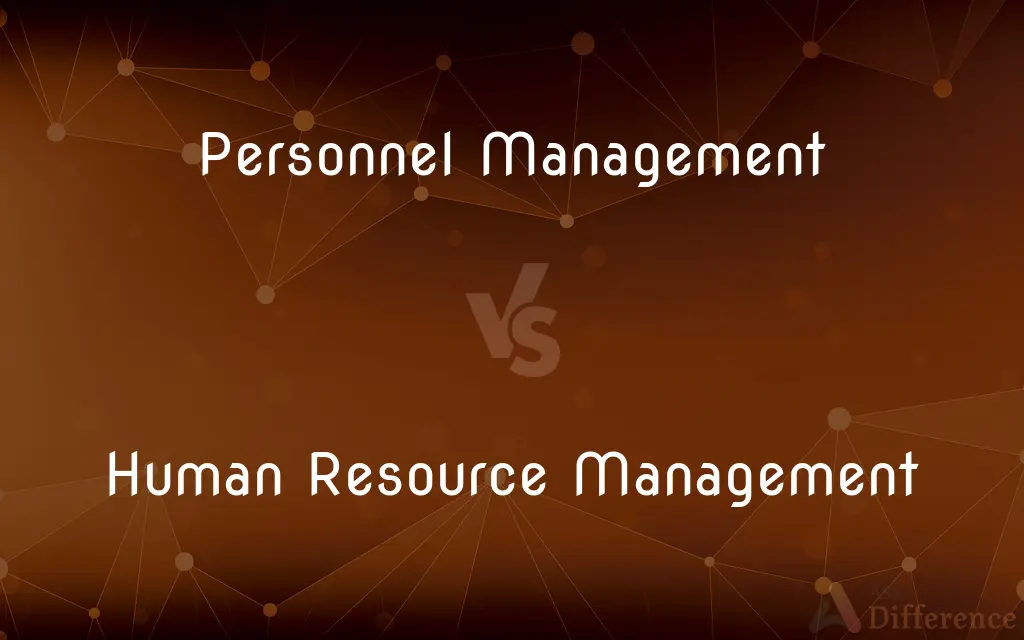Personnel Management vs. Human Resource Management — What's the Difference?
By Tayyaba Rehman — Published on October 12, 2023
Personnel Management focuses on employee administration and basic employee relations; Human Resource Management involves a strategic approach to manage people and foster a suitable work environment.

Difference Between Personnel Management and Human Resource Management
Table of Contents
ADVERTISEMENT
Key Differences
Personnel Management and Human Resource Management, while closely related, embody different philosophies and approaches in managing an organization's workforce. Personnel Management is traditionally considered the older, more administrative function dealing with the management of employee payroll, welfare, and maintaining employee records. Its approach is often reactive, responding to demands as they arise, and it is primarily concerned with managing employees, ensuring compliance with employment law, and dealing with employment contracts.
Conversely, Human Resource Management is more proactive, focusing on strategies to manage people within an organization in a way that adds value to the organization and contributes to its success. It encompasses a wider range of activities, including employee recruitment, training and development, performance management, and employee engagement. Human Resource Management aims to create a positive work environment, encouraging employee development and seeking to align individual goals with those of the organization.
The distinction is significant as it marks a shift from merely managing employee needs and concerns to utilizing human resources as a strategic asset for the organization. Personnel Management typically implies a clerical, maintenance-oriented approach, focusing on day-to-day administration of employees and their concerns. Human Resource Management, however, signifies a more comprehensive, management-oriented approach, emphasizing employee development, organizational culture, and employee-employer relationships, seeking to achieve a balance between organizational goals and employee satisfaction.
In practice, Personnel Management tends to be task-oriented, dealing primarily with the administrative aspects of employee management such as payroll, compliance, and employee relations. Human Resource Management, on the other hand, is more people-oriented and development-focused, dealing with employee motivation, development, and engagement, aiming to optimize employee performance and, consequently, organizational success.
The transformation from Personnel Management to Human Resource Management indicates a recognition of employees as valuable assets and contributors to organizational success, rather than just administrative entities. Human Resource Management's holistic and strategic approach not only enhances employee satisfaction and development but also contributes to achieving organizational objectives and long-term success.
ADVERTISEMENT
Comparison Chart
Approach
Administrative and reactive.
Strategic and proactive.
Focus
Employee administration and relations.
Managing people and organizational development.
Scope
Narrow, task-oriented.
Broader, people-oriented.
Goal
Compliance and employee welfare.
Employee development and organizational success.
Perspective
Transactional, maintaining employee records and welfare.
Transformational, fostering a suitable work environment and culture.
Compare with Definitions
Personnel Management
It is typically concerned with employee administration and compliance.
Personnel Management was responsible for maintaining detailed records of employee attendance and leave.
Human Resource Management
Human Resource Management seeks to create a positive work environment and foster employee development.
The initiatives by Human Resource Management significantly improved employee morale and job satisfaction.
Personnel Management
It primarily involves managing employee relations and welfare.
Personnel Management played a key role in resolving the employee disputes in the organization.
Human Resource Management
It involves optimizing the workforce to add value to the organization and achieve its goals.
Human Resource Management was instrumental in aligning employee objectives with the organizational goals.
Personnel Management
Personnel Management often has a reactive approach, dealing with issues as they arise.
Personnel Management swiftly addressed the concerns raised by employees regarding workplace safety.
Human Resource Management
It encompasses recruitment, training, performance management, and employee engagement.
Human Resource Management was proactive in identifying and addressing employee training needs.
Personnel Management
Personnel Management is a traditional approach focusing on administrative activities related to employee management.
Personnel Management ensures accurate employee payroll and adherence to employment laws.
Human Resource Management
Human Resource Management emphasizes employee-employer relationships and organizational culture.
The strategies employed by Human Resource Management enriched the organizational culture and strengthened employee relationships.
Personnel Management
Personnel Management is characterized by a focus on rules, regulations, and procedures.
Through strict adherence to company policies, Personnel Management maintained a harmonious work environment.
Human Resource Management
Human Resource Management is a strategic approach focused on managing people within an organization.
Human Resource Management implemented programs to enhance employee skills and productivity.
Common Curiosities
What is the main focus of Personnel Management?
Personnel Management mainly focuses on administrative tasks and employee relations.
Does Personnel Management deal with employee welfare?
Yes, it deals with managing employee welfare and maintaining employee records.
Is Human Resource Management more strategic?
Yes, it involves a strategic approach to managing people and fostering organizational development.
Is Personnel Management more reactive?
Yes, it typically reacts to demands and issues as they arise.
Is Personnel Management narrower in scope?
Yes, it has a narrower, more task-oriented focus on administrative aspects of employee management.
Does Human Resource Management focus on employee development?
Yes, it focuses on employee development, engagement, and aligning individual goals with organizational objectives.
Does Human Resource Management enhance organizational culture?
Yes, it emphasizes enriching organizational culture and strengthening employee-employer relationships.
Can Personnel Management address employee disputes?
Yes, it plays a role in addressing and resolving employee disputes and concerns.
Does Human Resource Management contribute to organizational success?
Yes, its strategic approach contributes to achieving organizational objectives and long-term success.
Does Human Resource Management optimize employee performance?
Yes, it aims to optimize employee performance and development to meet organizational goals.
What is the goal of Human Resource Management?
The goal is to strategically manage people to add value to the organization and contribute to its success.
How does Personnel Management maintain a harmonious work environment?
By adhering to company policies, rules, and regulations, and addressing employee concerns promptly.
Is Personnel Management primarily concerned with compliance?
Yes, it is concerned with ensuring compliance with employment laws and regulations.
Share Your Discovery

Previous Comparison
Capital vs. Drawings
Next Comparison
Opportunity Cost vs. Money CostAuthor Spotlight
Written by
Tayyaba RehmanTayyaba Rehman is a distinguished writer, currently serving as a primary contributor to askdifference.com. As a researcher in semantics and etymology, Tayyaba's passion for the complexity of languages and their distinctions has found a perfect home on the platform. Tayyaba delves into the intricacies of language, distinguishing between commonly confused words and phrases, thereby providing clarity for readers worldwide.














































